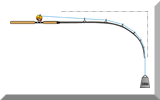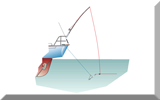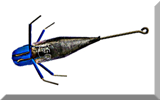- Home
- All About Rods
- Bass Fishing Rod
Is Your Bass Fishing Rod Just a Mini-Beachcaster?
Just what is a bass fishing rod? What's so special about them? Are seabass now so sought-after by sea anglers that they're entitled to their own rods?
I do struggle a little with the concept of a rod 'just for bass fishing', as surely what defines a rod is its suitability for a particular set of conditions, rather than just the type of fish you'd like to catch with it.
Surf rods, spinning rods, jigging rods, trolling rods, fly fishing rods I can understand - but bass fishing rods?
Ok, I'll stop banging on about it, as specialist bass rods are unquestionably a delight to use.
So then, accepting that bass rods are here to stay, by my reckoning you need a couple of them:~
|
 |
A Bass Rod for Bait Fishing
Seabass are usually found quite close in, hunting for small fish, marine worms and crabs dislodged by the surf. This is pretty sporting of them, as it means that long-casting rods aren't necessary - around 11ft to 12ft (3.4m to 3.7m) will be fine - and they won't have to cast weights of more than 5oz (that's 150g approximately).
Most are optimised for quite narrow weight casting ranges - 2oz to 30z, and 3oz to 5oz being typical. This information - length and casting weight range - will be marked on the rod, just above the handle.
As most bass anglers prefer to hold their rod rather than leave it in a rod rest, requirement number one for a bass rod is that it must be light. So forget glassfibre - a good, modern bass rod will be built around a carbon blank or other hi-tech composite.
In all other regards, a specialist bass surf rod is just a shorter, slimmer and lighter version of a full-on surf rod.
One other difference though, is that whilst top-of-the-range surfcasters are usually optimised for use with either a multiplier (baitcast) reel or a fixed-spool (spinning) reel and marked as such, bass fishing rods can generally be used with both reel types.
"Why's that then?"
Well, long-range casting capability isn't the prime design criterion. It's more important to have a bass rod that is light and comfortable to use, and can accommodate the bass angler's personal preference with regards to reel type. Let's face it, bass fishing fanatics can be a bit picky!
"So how is this reel-type flexibility achieved?"
It's all to do with the size and number of line guides:~
- By placing the line guides close enough together so that when used 'upside down' with a multiplier (baitcaster) reel, the line is kept clear of the blank, and
- By using line guides that are large enough to accommodate the coils of line that are released when casting with a spinning reel.
A Bass Fishing Rod for Lure Fishing
It's probably the recent developments in bass lures that's accounted for the increasing popularity of spinning for bass.
And when I say 'spinning', I mean casting not just with spinners and spoons, but also with surface poppers, diving plugs, and soft plastic lures.
Bass spinning rods are usually between 7ft and 9ft long and designed to cast lures from 10gr to 40gr in weight - which means they are versatile enough to be used as light boat rods and jigging rods.
and finally...
Rod rings (or line guides as they're also known) are the most vulnerable items on any fishing rod, so it's worth going for a bass fishing rod with really good quality rings on it, such as those made by Fuji or Seymo.
These will be very hard, low-friction acrylic liners made from silicon carbide, zirconium or a similar material. They're essential if you're going to use braided line, which would quickly groove inferior rod rings.
But is you do decide to buy a specialist bass fishing rod, don't be surprised if from time to time it inadvertently catches a few mackerel, pollack, flatties, dogfish, cod, mullet...
Recent Articles
-
Sea Fishing Rods and Reels Must Be Compatible for a Balanced Outfit
Mar 08, 21 08:30 AM
A quality reel fitted to a quality rod doesn't necessarily make it a quality outfit. Your fishing rods and reels have to be properly matched if you're to get the best out of them, and here’s how -
Essential Lure Fishing Tips That All Saltwater Anglers Should Know
Mar 08, 21 04:51 AM
Which single lure fishing tip applies to trolling, jigging, baitcasting, spinning, fly fishing and any other branch of lure fishing? Well, it is the one at the top of this list -
Vital Jig Fishing Tips That You Really Cannot Afford To Miss!
Mar 07, 21 10:20 AM
Essential jig fishing tips to help you select the right lure for successful jig fishing, together with the techniques required to get the most out of your jig fishing outfit


















New! Comments
Have your say about what you've just read! Leave me a comment in the box below.